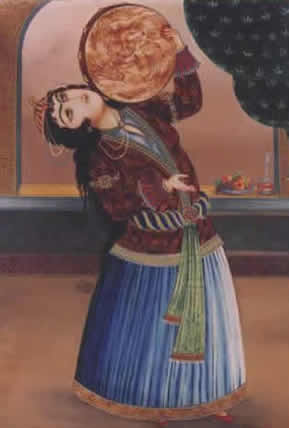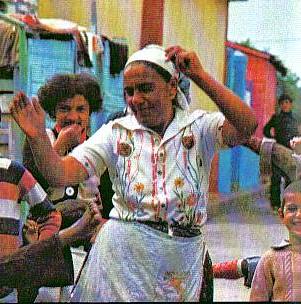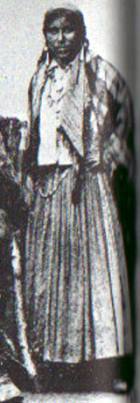Gypsies: Roots of bellydance
The gypsies, wandering artists
Gypsies originated according the legend from the Sindh or "bilad as-sind" (translated: land of the sind), a southern province of Hindustan (nowadays Pakistan).
Now before that, some five thousand years ago, the gypsies came from Egypt to Hindustan. Bringing with them instruments like the Alghoza, a pare of beak flutes. The alghoza became quickly the most popular instrument in the Sind province.
Hamza of Isfahan relates around 950 that the Persian ruler, shah Bahram Gur went to Hindustan to meet king Shangul. Bahram, a popular name for many Persian Kings, asked him to select musicians, male and female alike. So Shangul choose among the Luri tribe around 12.000 persons capable of playing oud. The story was later repeated by Firdouzi. According to the sources the tribe was also called Zott (single. Zotti) or Zitti and calling themselves "Romas," from the Sanskrit word meaning "man of the low caste of musician."
Other sources talk about the "sons of Rama", a legendary brotherhood of ancient India.
Another interesting theory is that çengi is derived from the Persian word zangi. The Dayereh zangi is a kind of frame drum used by the wandering musicians in Persia. Dayereh-zangi - also doyra, dojra, dajre, doira, dajreja - translates roughly as tambourine, an traditional instrument much used by the gypsies to accompany their dances. This round framedrum, hence the Persian name meaning "circle", has jingles

The wandering gypsy tribes were mentioned for the first time in European history in the Romanian archives in 1385 as atsigani. Around 15 th century they spread over the rest of Europe. Some of them gained a living as musicians and dancers as a 16 th century Flemish wall carpet shows.

The Manusj or Manoesjen (Sinti) arrived in the Netherlands (now Belgium and Holland) around the 15 th century. Some gypsy families settled and curiously enough the neighborhood where they lived became know as "Turkije" (Turkey) to indicate their roots.
The Rom tribe spread out centuries ago to Turkey, the Balkan, the Maghreb (North Africa), Iberia (Spain and Portugal) as well as France and Belgium where they arrived in the 19 th century.

The wandering gypsy tribe
An 1420 account of the city of Deventer in central Holland mentions a donation to "Andreas, Hertoch van Cleyn Egypte" (Andrew, the earl of Little Egypt). This was the leader of the dark skinned nomads that erroneously believed to have come from Egypt.
The "Egiptians dancing for the King in Holyrood House" received 40 shilling for their show from King James V - king of Scotland - in 1529. 78 years later another British king James I, azka James VI of Scotland, invited in 1607 gypsies to dance at the court. The tchingui as they were known in Ottoman Turkey, danced frequently in the harem and for the entertainment of the sultan and his guests.
Medieval Bohemia's population included large numbers of gypsies dark-skinned nomads. The gypsies were the Bohemians who wandered into France in the 15 th century as itinerant blacksmiths and entertainers, forging traditions that continue today in Roma tribes worldwide, still subsisting on society's fringes by luck and sharp wits. Bohemian became a synonym of gypsy in some European countries.
Among the many styles of Romany dance, perhaps the most wellknown is Flamenco, the typical dance from Andalusia in the south of Spain. Other styles are Ghawazee (Egyptian Gypsies), Rom (East-European Gypsies) and Tsjengui (Turkish Gypsies). The Turkish gypsies crossed Turkey through the northern Black Sea region (Kara Deniz) and moved on to Trakya passing Istanbul (former Constantinopel). In Istanbul the Sulekule district is still famous for it's gypsy dancers - who have a dubious reputation by the way - and interesting turkish gypsy music.
